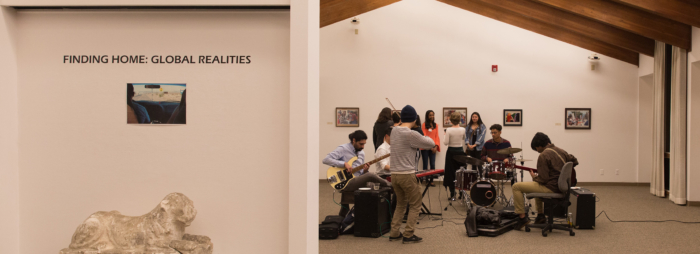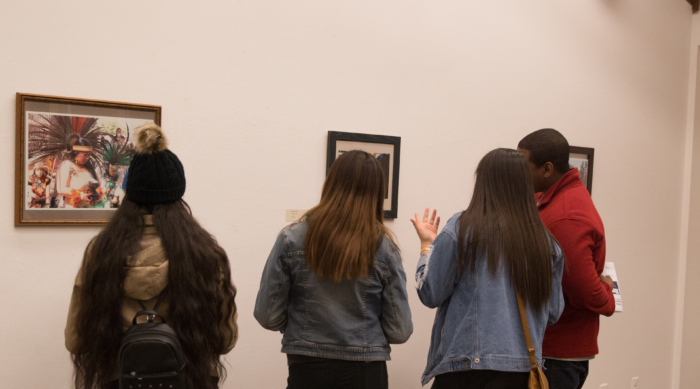
At the Clark Humanities Museum, students augment in-classroom learning by encountering original works of art and other cultural objects. The museum was established at Scripps in 1970 as a study space and exhibition venue for explorations in the humanities. Its exhibitions often reflect the current curriculum, with faculty and students from across the 5Cs invited to submit proposals that relate to classes, programs, or research interests.
A recent exhibition, Finding Home: Global Realities, was organized by Humanities Institute Director and Scripps Professor of Music Hao Huang in collaboration with the spring 2018 Humanities Institute Fellows, Scripps students nominated by faculty to participate in a semester-long Humanities Institute seminar. Expanding on the seminar topic, “Exclusive Nationalisms: Global Migration and Immigration,” Finding Home showcased the work of local artists grappling with feelings around difference and belonging in their own immigrant communities.

In one section of the exhibition, an installation of chairs by artist Saba Hakimi touched on the difficulties of leaving home. “The chairs represent for her a place, a home. It’s where you sit, where you make your life,” says Huang. Textile-based works by Eunhae Yoo rooted in Korean patchwork, a tradition of sewing together scraps of fabric to wrap and carry objects, were also on view. “The fabric suggests putting things in and going somewhere, which relates to the immigrant experience,” says Huang. “Her artwork also symbolizes loss, because immigrants can’t carry everything with them. They have to give something up.”
One interesting aspect of Finding Home was the absence of wall text to explain the meaning of the art. For Huang, the act of interpreting without much context may prompt questions like, “What does this mean?” “What am I supposed to feel?” or “How am I supposed to interact with this?” Such questions—and some of the feelings they elicit—may echo those of an immigrant experiencing a new country.
Carmen Sanjuán-Pastor, Scripps associate professor of Hispanic studies, recently visited Finding Home with her Spanish 44 class. Together, they toured the exhibition, and then each student presented an analysis of a work or works on view.
“It was so beneficial to have tangible objects that you can see and interact with,” says Becca Weiness ’19. “Having that sort of direct experience often gives me more a personal understanding.”
Sanjuan agrees, adding that viewing and then discussing new art and ideas together also breaks down the hierarchy between students and professor.
“Because we were all learning together, I sensed that my students felt freer to create their own thinking about the artworks.”
As the semester draws to a close, the Clark Humanities Museum will host one final exhibition, Visions of a Living Culture, organized by Gina Lamb, a visiting assistant professor of media studies at Pitzer College, in collaboration with Serrano and Cahuilla elder Kim Marcus and CUC students in Media Arts for Social Justice. Now on view, the exhibition explores the past, present, and future of indigenous communities and culture and features an array of Cahuilla and Serrano artifacts. Through hands-on activities, visitors will be able to experience the traditional art of processing native foods. Visions of a Living Culture runs until May 12.
For more information about the Clark Humanities Museum, click here.

